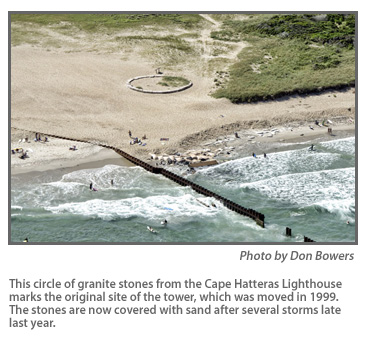In 1999, the National Park Service moved the Cape Hatteras Lighthouse about 2,900 feet to the southwest to protect it from the encroaching Atlantic Ocean.
Moving the lighthouse along a track for that distance was called ?The Move of the Century.? It was an engineering feat of historic proportions and was covered by media from around the world and watched by up to 15,000 lighthouse fans each day during June and July of 1999.
Moving the Cape Hatteras Lighthouse from its historic setting next to the sea was vehemently opposed at the time by some Hatteras islanders, who felt there were other steps that could be taken to stave off the shoreline erosion.
Since then, islanders, even those who were opposed to the move, have accepted it and have gotten used to seeing the tower in its new location a half mile inland in a forest of scrub pine and myrtle bushes.
After the lighthouse was moved, the Outer Banks Lighthouse Society paid almost $12,000 to have original granite stones from the lighthouse foundation ? stones that were cut away to prepare for the move ? engraved with the names and dates of all of the keepers of the Hatteras light.
 The huge, heavy granite stones, each weighing 3,000 pounds or more, were arranged in a circle to mark the original location of the historic lighthouse.
The huge, heavy granite stones, each weighing 3,000 pounds or more, were arranged in a circle to mark the original location of the historic lighthouse.
The stones were unveiled on May 5, 2001, during a reunion of the descendants of the lightkeepers, sponsored by the lighthouse society, and the Park Service?s re-dedication of the Cape Hatteras Light Station.
Over the years, the circle of stones has become a site for tourists to visit and for locals to gather. The circle has also been the site of many weddings, memorial services, and even some christenings.
It?s a place of great historic and sentimental significance for both islanders and visitors.
In the past decade, the stones have been tossed around by big waves and covered with sand after several hurricanes and northeasters.
This has been happening with increasing frequency, and the stones have been almost entirely covered by sand since Hurricane Sandy and several northeasters late last year.
Now, the Park Service says it is no longer practical to keep uncovering and rearranging the stones after each storm.
In a letter to the Outer Banks Lighthouse Society last month, seashore superintendent Barclay Trimble said, ?Because of coastal processes, namely shoreline erosion and dune migration, the stones have routinely become covered with sand requiring substantial effort to keep them uncovered.?
The park says it no longer intends to keep maintaining the stones at the site and is seeking the lighthouse society?s input on two alternatives.
One would be to leave the stones covered and in place, which ?would provide an opportunity to interpret coastal processes.? However, Trimble warns the time will come when the entire circle will be inaccessible for viewing ? presumably because it would be under water.
The other alternative that the superintendent proposes is transferring the stones to another organization, such as the Graveyard of the Atlantic Museum in Hatteras village, which has a Cape Hatteras Lighthouse exhibit, including the original first-order Fresnel lens.
The lighthouse society says it never received Trimble?s letter, dated May 17, and did not know about the park?s intentions until this week.
Bett Padgett, president of the Outer Banks Lighthouse Society, says the entire board of directors is unanimous in its view that neither alternative is acceptable.
Bruce and Cheryl Roberts, co-founders of the lighthouse society and the folks who were instrumental in getting the stones carved with the names of the keepers, couldn?t agree more.
The group does not want to see the stones buried in sand and/or covered with water nor does it want to see the stones move 10 or so miles down the road from the light station to the museum.
?The Outer Banks Lighthouse Society is not going to stand by and let this happen,? Padgett said this week.
The society does want to work with the Park Service on a solution that will work for all.
Padgett and the lighthouse society board want to see the circle of stones kept together and in the vicinity of the Cape Hatteras Light Station, perhaps on the grounds between the current lighthouse location and the double-keepers? quarters.
They want to see more weddings and memorial services and other special gatherings in the circle of stones ? because, they are, above all, to most of us, much more than just a circle of stones.
Liz Browning Fox of Buxton, a member of an island family, put it this way after a blog I wrote on this topic a few weeks ago:
?I am ? dismayed to hear that the NPS will not continue to maintain the ring of stones at Old Cape Hatteras Lighthouse location. There is history, the pride of the island families, and the story of the lighthouse move all at stake here. I have observed countless visitors reading the sign and the names of the past lighthouse keepers etched on the stones, walking all around the location. I?ve happened upon several beautiful weddings within the circle. It is a historically significant location and the park should budget for its care.?



